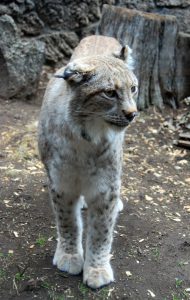 We’re excited to have just added a fifth owl species to our collection: the barred owl. This beautiful and remarkable species joins our popular hawks, eagles and falcons currently on exhibit.
We’re excited to have just added a fifth owl species to our collection: the barred owl. This beautiful and remarkable species joins our popular hawks, eagles and falcons currently on exhibit.
The barred owl is a large owl native to the mixed deciduous/coniferous forests of the eastern U.S. Throughout the 20th century, the species made a rapid westward expansion, possibly across the Northern Great Plains or Canadian boreal forest, into the Washington Cascades, and now south into Oregon and California. The owl has become controversial due to its status as an invasive species (a non-native species that causes economic or environmental harm) whose presence has severely impacted spotted owl populations in the Northwest.
A species is not considered native to a particular ecosystem in the US merely because it is native somewhere else within the U.S. Human alterations of forest ecosystems are responsible for the barred owl’s westward expansion and its capacity to thrive in the Pacific Northwest.
The barred owl is bigger, more aggressive, and nests in higher density. They disrupt the nesting of the spotted owl, compete with them for food, and literally chase them out of the area. In habitats where the barred owl competes with the northern spotted owl, the barred owl tends to win every time.
Wildlife managers entrusted to protect the spotted owl’s dwindling populations are now faced with a painful choice: Allow the invasive barred owl to continue displacing the spotted owls – likely resulting in the eventual extinction of the northern spotted owl — or, protect existing populations of spotted owls by removing barred owls found within spotted owl habitat. The U.S. Fish & Wildlife Service has concluded that the strategic removal of barred owls may be key to the future of the spotted owl. They’ve started an experimental barred owl removal program in California, Oregon and Washington to evaluate whether removals will benefit spotted owl populations.
Although removal programs often elicit controversy, endangered species biologists only use such measures when the loss of a listed species (or population) is likely without intervention. The brown-headed cowbird and corvids (ravens, crows, jays etc.) are examples of wildlife native to North America that became invasive due to human-caused changes to various habitats that gave them an unnatural advantage. Their targeted removal in small areas was critical to maintaining viable populations of endangered species like the snowy plover and Kirtland’s warbler.
Having a barred owl on exhibit at our Bird of Prey Center allows the Museum to present important information about spotted owl conservation while also exhibiting a fascinating owl species.
The High Desert Museum’s barred owl came from a rehabilitation facility in Washington. The young bird did not develop some of its flight feathers correctly, so it cannot survive in the wild. There are four other owl species on exhibit: The barn owl, great horned owl, burrowing owl and screech owl. In all, there are more than 20 birds of prey in the Museum’s live collection.
– By John Goodell, Curator of Natural History

 Snowshoe, a male hybrid lynx who lived at the High Desert Museum for nine years, died last night, November 10, 2014. He had been under a veterinarian’s care recently for kidney failure. Snowshoe’s exact age isn’t known but it’s believed he was in his 20s, having lived much longer than lynx do in the wild.
Snowshoe, a male hybrid lynx who lived at the High Desert Museum for nine years, died last night, November 10, 2014. He had been under a veterinarian’s care recently for kidney failure. Snowshoe’s exact age isn’t known but it’s believed he was in his 20s, having lived much longer than lynx do in the wild. “He was lying in sphinx position”. Osborn says he tried to make himself look big and made loud noises — but the lynx “wasn’t impressed”. The cat “looked at me curiously and yawned, then stretched like a dog and started walking straight toward me.”
“He was lying in sphinx position”. Osborn says he tried to make himself look big and made loud noises — but the lynx “wasn’t impressed”. The cat “looked at me curiously and yawned, then stretched like a dog and started walking straight toward me.” Around the world, people have associated owls with mystery, witchcraft and even death. After all, they are creatures of the night, and we humans are inherently fearful of the dark: what we cannot see could hurt us.
Around the world, people have associated owls with mystery, witchcraft and even death. After all, they are creatures of the night, and we humans are inherently fearful of the dark: what we cannot see could hurt us.
 The slow-flying pigeon didn’t have a prayer. From high above, the peregrine falcon zeroed in on its prey, tucked his wings, and dove. With speed topping 200 miles an hour, it struck, talons first, and dispatched the bird from the air. It was mercifully instantaneous.
The slow-flying pigeon didn’t have a prayer. From high above, the peregrine falcon zeroed in on its prey, tucked his wings, and dove. With speed topping 200 miles an hour, it struck, talons first, and dispatched the bird from the air. It was mercifully instantaneous. “People are naturally fascinated by these birds,” said John Goodell, Curator of Natural History at the High Desert Museum. “They’re just so majestic and impressive to watch, especially when they fly so close overhead. You’ll never have an experience like this in the wild.”
“People are naturally fascinated by these birds,” said John Goodell, Curator of Natural History at the High Desert Museum. “They’re just so majestic and impressive to watch, especially when they fly so close overhead. You’ll never have an experience like this in the wild.”